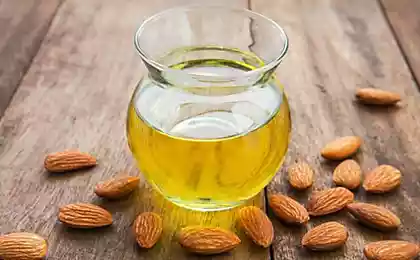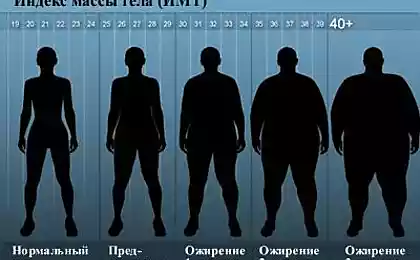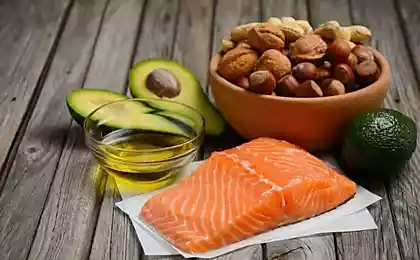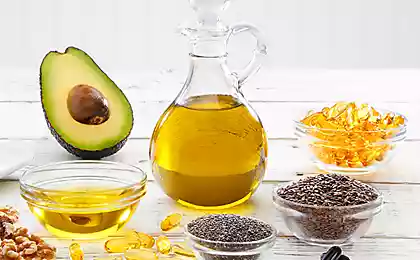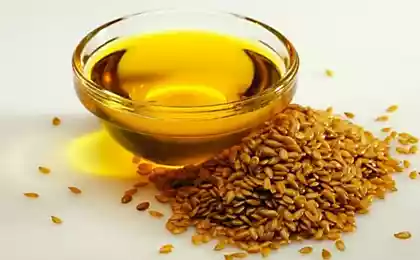680
WHAT you did not know the "healthy" vegetable oils
If you are even slightly interested in the subject of proper nutrition, then you've probably heard about the benefits of replacing saturated fat with polyunsaturated, i.e. animal fats and vegetable oils. For decades it was one of the main dietary principles.
For example, the current official us recommendations for healthy eating from 2010 stated that fats should give 20-35% of calories in the daily diet, but saturated not more than 10%. These recommendations clearly had an impact on consumer habits — the consumption of animal fats is practically not grown, but the plant grew from 1995 to 2.4 times.

Judging by the discussions concerning the update of dietary recommendations in 2015, the expert Committee proposes to withdraw a higher limit consumption of all fats, but the position in relation to the rich remains unchanged. This causes a lively criticism from many experts who believe that increased consumption of vegetable oils is one of the main causes of obesity and many related diseases.
Forbes magazine published an article on this subject written by two American doctors — cardiologist James Dinicolantonio and family therapist Sean Lacan. Both authors of the article have long been engaged in research in the field of obesity and healthy diet and are acknowledged experts in these matters. Published translations Osnovnye article:
In the second half of the twentieth century, the concern about saturated fats and their role in the development of cardiovascular diseases has led to the fact that many dietary recommendations called for the replacement of saturated fats with that of unsaturated. The result is liquid vegetable oils began to replace solid fats (e.g., butter).
Over the past decades the consumption of vegetable oils such as soybean, canola, corn, sunflower, cotton seeds, safflower, significantly increased. For example, from 1970 to 2000, the consumption of soybean oil increased from 4 pounds per year per person up to 24 pounds.
All oils listed above are a rich source of unsaturated fatty acids. And especially rich in many of these oils in linoleic acid. Perhaps the consumption of this acid dose, to which we are prepared by evolution.
Linoleic acid gives to modern man for about 8% of all calories consumed, as before the advent of agriculture, this share was equal to 1-3%. In other words, we are now consumed in 2.5 to 8 times more linoleic acid than for hundreds of thousands of years of evolution to the relatively recent advent of agriculture (and even more recent emergence of the food industry).
Can this apparent jump in the consumption of linoleic acid exceed our tolerance, to increase the circumference of our Empire and undermine our health? It is quite possible.
We know from experiments on mice that increased intake of linoleic acid from 1% to 8% can cause the brain to send signals, require to eat more. In addition, it will contribute to fat deposition. It seems that the increased consumption of linoleic acid lowers the feeling of satiety and increases the size of fat cells.
Introduction in the diet of mice linoleic acid (i.e., soybean oil) resulted in obesity and diabetes and had a pronounced negative effect compared with the introduction of coconut oil (high saturated fat) or fructose (whose relationship with various health problems and abdominalna deposition of fat is well proven).
People linoleic acid can also cause obesity and related problems. In randomized clinical experiment where the participants received soybean oil or coconut oil, coconut oil (solid saturated fats) led to a decrease in abdominales fat, while the soybean oil with a high content of linoleic acid, may have made participants and fatter, exactly, led to the deterioration of their cholesterol profile.
How linoleic acid increases our risk of obesity and related problems? One explanation may lie in the fact that linoleic acid (omega-6) competes with other polyunsaturated fatty acids such as omega-3 and disrupts their effect on the body. At the time, as people the Paleolithic consumed omega-6 and omega-3 in a 1:1 ratio in modern Western diets the ratio is 16:1.
Consumption of sufficient amounts of fatty acids omega-3 can prevent caused by omega-6 obesity. But high consumption of omega-6 without adequate intake of omega-3 can lead to insulin resistance and prediabetes. Excess omega-6, including linoleic acid, can prevent the transformation of white fat (which is deposited in reserve) in brown (used as energy).
Linoleic acid may be violating fetal and postnatal development. When the diet of one group of pregnant or lactating mice was added a large amount of linoleic acid, and other diet — balanced amount of omega-6 and omega-3, it was noted that only a diet rich in linoleic acid, has caused obesity and diabetes in young.
A possible reason for this effect is the ability of linoleic acid to stimulate the development of new fat cells from cells-precursors. If the same effect is confirmed in humans, this would mean that high intake of linoleic acid during pregnancy or nursing can lead to the birth of children with more weight or that they gain excess weight later. Mix baby food with a high content of linoleic acid can also contribute to the development of childhood obesity.
Taking into account recent discoveries, is of great concern that dietary recommendations still include the advice to replace saturated fatty acids with oils high in linoleic acid omega-6. For example, the American heart Association still recommends Americans get 5-10% of their calories from oils high in omega-6.
This is due partly to the fact that saturated fats raise cholesterol levels, while omega-6 can lower it, which means this change can lead to reduced morbidity and better health. Although it may, in reality things are quite the contrary: the replacement of saturated fats with oils high in omega-6 can lead to increased risk of heart disease and death. These recommendations need to be revised.
The authors refer mostly to soy oil, as it is the most popular vegetable oil in the United States — 63% of the total consumption of vegetable oils.

In Russia the most popular is the sunflower oil — 85% of the market. The content of linoleic acid in sunflower oil 68%, significantly higher than in soy — 51%. This means that for the Russian consumers, the balance of omega-6/omega-3 fatty acids is likely to be even more unhealthy than the American, especially given the fact that Russians consume a lot less more healthy types of vegetable oils — such as olive and coconut.
Ongoing economic crisis and the resulting decline in purchasing power and rise in prices of imported products leads to the consumption of cheap domestic oil — primarily sunflower — will continue to grow, and expensive imported — fall. In addition, in connection with the crisis and sanctions has dramatically increased the demand for margarine is also produced from vegetable oils, as for many consumers it becomes an affordable alternative to expensive butter. All this, of course, poses serious problems for the health of the population in the country.
In addition, it is worth remembering that a high content of linoleic acid is not only "popular" sunflower oil, but also expensive kinds of oils with a reputation as "healthy" alternatives — for example, walnuts (51%) or grape seed (73%). But in palm oil, which is accepted to accuse of all sins, linoleic acid is much less — 10% in coconut is even less — 2%.
It is worth remembering that omega-6 are essential, ie the body can't synthesize them independently. We are not talking about total exclusion of them from the diet. Moreover, there is no such danger, even if completely to refuse from vegetable oils because they are part of many products — for example, egg yolks (3,5%), chicken fat (18-23%), almost all nuts. But the consumption of omega-6 should be very moderate and balanced appropriate intake of omega-3 (fatty fish, Flaxseed oil, Chia seeds).published
Below we provide a table of contents of linoleic acid in the popular vegetable oils:
Safflower oil 78% grape seed 73% of the Poppy 70% Sunflower 68% Hemp 60% Corn 59% Cotton 54% Soybean 51% Of walnut 51% Sesame 45% of rice bran 39% Pistachio 32.7% Peanut 32% Almonds 21%, Rapeseed 21% False 20% Mustard seed 15% Linseed 15% avocado 15% Olive 10% Palm, 10% cocoa Butter 3% macadamia nut 2% Coconut 2%
14 natural juices and smoothies to reduce cholesterol
Intrusive negative thoughts — WHAT to DO
Source: lchf.ru/7712
For example, the current official us recommendations for healthy eating from 2010 stated that fats should give 20-35% of calories in the daily diet, but saturated not more than 10%. These recommendations clearly had an impact on consumer habits — the consumption of animal fats is practically not grown, but the plant grew from 1995 to 2.4 times.

Judging by the discussions concerning the update of dietary recommendations in 2015, the expert Committee proposes to withdraw a higher limit consumption of all fats, but the position in relation to the rich remains unchanged. This causes a lively criticism from many experts who believe that increased consumption of vegetable oils is one of the main causes of obesity and many related diseases.
Forbes magazine published an article on this subject written by two American doctors — cardiologist James Dinicolantonio and family therapist Sean Lacan. Both authors of the article have long been engaged in research in the field of obesity and healthy diet and are acknowledged experts in these matters. Published translations Osnovnye article:
In the second half of the twentieth century, the concern about saturated fats and their role in the development of cardiovascular diseases has led to the fact that many dietary recommendations called for the replacement of saturated fats with that of unsaturated. The result is liquid vegetable oils began to replace solid fats (e.g., butter).
Over the past decades the consumption of vegetable oils such as soybean, canola, corn, sunflower, cotton seeds, safflower, significantly increased. For example, from 1970 to 2000, the consumption of soybean oil increased from 4 pounds per year per person up to 24 pounds.
All oils listed above are a rich source of unsaturated fatty acids. And especially rich in many of these oils in linoleic acid. Perhaps the consumption of this acid dose, to which we are prepared by evolution.
Linoleic acid gives to modern man for about 8% of all calories consumed, as before the advent of agriculture, this share was equal to 1-3%. In other words, we are now consumed in 2.5 to 8 times more linoleic acid than for hundreds of thousands of years of evolution to the relatively recent advent of agriculture (and even more recent emergence of the food industry).
Can this apparent jump in the consumption of linoleic acid exceed our tolerance, to increase the circumference of our Empire and undermine our health? It is quite possible.
We know from experiments on mice that increased intake of linoleic acid from 1% to 8% can cause the brain to send signals, require to eat more. In addition, it will contribute to fat deposition. It seems that the increased consumption of linoleic acid lowers the feeling of satiety and increases the size of fat cells.
Introduction in the diet of mice linoleic acid (i.e., soybean oil) resulted in obesity and diabetes and had a pronounced negative effect compared with the introduction of coconut oil (high saturated fat) or fructose (whose relationship with various health problems and abdominalna deposition of fat is well proven).
People linoleic acid can also cause obesity and related problems. In randomized clinical experiment where the participants received soybean oil or coconut oil, coconut oil (solid saturated fats) led to a decrease in abdominales fat, while the soybean oil with a high content of linoleic acid, may have made participants and fatter, exactly, led to the deterioration of their cholesterol profile.
How linoleic acid increases our risk of obesity and related problems? One explanation may lie in the fact that linoleic acid (omega-6) competes with other polyunsaturated fatty acids such as omega-3 and disrupts their effect on the body. At the time, as people the Paleolithic consumed omega-6 and omega-3 in a 1:1 ratio in modern Western diets the ratio is 16:1.
Consumption of sufficient amounts of fatty acids omega-3 can prevent caused by omega-6 obesity. But high consumption of omega-6 without adequate intake of omega-3 can lead to insulin resistance and prediabetes. Excess omega-6, including linoleic acid, can prevent the transformation of white fat (which is deposited in reserve) in brown (used as energy).
Linoleic acid may be violating fetal and postnatal development. When the diet of one group of pregnant or lactating mice was added a large amount of linoleic acid, and other diet — balanced amount of omega-6 and omega-3, it was noted that only a diet rich in linoleic acid, has caused obesity and diabetes in young.
A possible reason for this effect is the ability of linoleic acid to stimulate the development of new fat cells from cells-precursors. If the same effect is confirmed in humans, this would mean that high intake of linoleic acid during pregnancy or nursing can lead to the birth of children with more weight or that they gain excess weight later. Mix baby food with a high content of linoleic acid can also contribute to the development of childhood obesity.
Taking into account recent discoveries, is of great concern that dietary recommendations still include the advice to replace saturated fatty acids with oils high in linoleic acid omega-6. For example, the American heart Association still recommends Americans get 5-10% of their calories from oils high in omega-6.
This is due partly to the fact that saturated fats raise cholesterol levels, while omega-6 can lower it, which means this change can lead to reduced morbidity and better health. Although it may, in reality things are quite the contrary: the replacement of saturated fats with oils high in omega-6 can lead to increased risk of heart disease and death. These recommendations need to be revised.
The authors refer mostly to soy oil, as it is the most popular vegetable oil in the United States — 63% of the total consumption of vegetable oils.

In Russia the most popular is the sunflower oil — 85% of the market. The content of linoleic acid in sunflower oil 68%, significantly higher than in soy — 51%. This means that for the Russian consumers, the balance of omega-6/omega-3 fatty acids is likely to be even more unhealthy than the American, especially given the fact that Russians consume a lot less more healthy types of vegetable oils — such as olive and coconut.
Ongoing economic crisis and the resulting decline in purchasing power and rise in prices of imported products leads to the consumption of cheap domestic oil — primarily sunflower — will continue to grow, and expensive imported — fall. In addition, in connection with the crisis and sanctions has dramatically increased the demand for margarine is also produced from vegetable oils, as for many consumers it becomes an affordable alternative to expensive butter. All this, of course, poses serious problems for the health of the population in the country.
In addition, it is worth remembering that a high content of linoleic acid is not only "popular" sunflower oil, but also expensive kinds of oils with a reputation as "healthy" alternatives — for example, walnuts (51%) or grape seed (73%). But in palm oil, which is accepted to accuse of all sins, linoleic acid is much less — 10% in coconut is even less — 2%.
It is worth remembering that omega-6 are essential, ie the body can't synthesize them independently. We are not talking about total exclusion of them from the diet. Moreover, there is no such danger, even if completely to refuse from vegetable oils because they are part of many products — for example, egg yolks (3,5%), chicken fat (18-23%), almost all nuts. But the consumption of omega-6 should be very moderate and balanced appropriate intake of omega-3 (fatty fish, Flaxseed oil, Chia seeds).published
Below we provide a table of contents of linoleic acid in the popular vegetable oils:
Safflower oil 78% grape seed 73% of the Poppy 70% Sunflower 68% Hemp 60% Corn 59% Cotton 54% Soybean 51% Of walnut 51% Sesame 45% of rice bran 39% Pistachio 32.7% Peanut 32% Almonds 21%, Rapeseed 21% False 20% Mustard seed 15% Linseed 15% avocado 15% Olive 10% Palm, 10% cocoa Butter 3% macadamia nut 2% Coconut 2%
14 natural juices and smoothies to reduce cholesterol
Intrusive negative thoughts — WHAT to DO
Source: lchf.ru/7712
Scientists of the Sandia lab uses tritium as the fusion fuel
Delightful soups that will warm up on a cold day - 3 recipes


